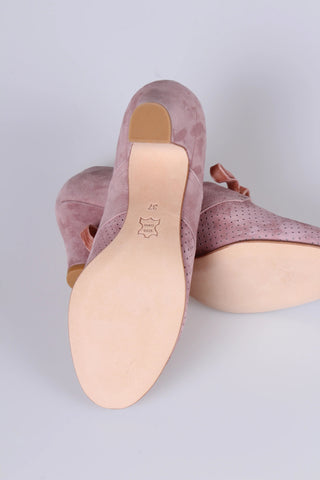When it comes to footwear, the choice of sole material can significantly affect comfort, durability, and style. Leather soles, though less common today, remain a favorite among discerning shoe enthusiasts. Here, we explore the advantages of leather soles, why we here at memery have chosen to have leather soles on most of our shoes and boots, and how to care for them to maximize their lifespan.
What Are the Benefits of Leather Soles?
Leather soles have stood the test of time, and for good reason. Here are the key benefits that make them a classic choice:
1. Comfort
Leather soles adapt to your walking pattern, creating a custom fit over time. This natural adjustment enhances comfort and can help support a better posture.
2. Breathability
Leather is a porous material, allowing air to circulate around your feet. This breathability helps prevent odors and keeps your feet dry and healthy.
3. Resoleability
Unlike rubber or plastic soles, leather soles can be easily replaced. This makes them a more sustainable option and extends the life of your favorite shoes.
4. Sustainability
Leather is a natural material known for its durability. With proper care, leather soles can last for years and can be resoled when needed, reducing waste.
5. Historically Authentic
Leather soles are historically accurate for vintage or period-specific footwear. They were the standard for centuries before modern materials emerged.
6. Ideal for Dancing
Leather soles are favored by dancers for their smooth, long-wearing properties. They allow for graceful turns and provide just the right amount of grip, reducing strain on knees.

Our Eleanor derby shoes, showing off their beautifully crafted leather soles, with the leather stamp in the middle.
Why Did Shoes Stop Having Leather Soles?
While leather soles were the standard for centuries, the invention of rubber soles in the late 1800s changed the game. Rubber initially gained popularity for military and sports shoes in the early 20th century, particularly during the rise of leisure activities in the 1920s and 1930s. However, leather soles remained dominant in everyday footwear until the 1960s and 1970s.
By the 1980s, sneakers with rubber soles became the norm, largely due to their convenience. Rubber soles required little to no maintenance, were water-resistant, and had been developed to offer flexibility, and durability. These practical benefits made rubber the go-to material for most modern shoes. However, it also contributed to the rise of the throwaway culture, as rubber and plastic soles cannot be replaced when worn out. Instead of repairing the shoes, the entire pair must be discarded.
Are shoes with leather soles good?
We firmly believe that shoes with leather soles are among the best choices for both shoes and boots. Not only do they stay true to the historical design of our traditional footwear, but they also offer unmatched benefits in terms of comfort, durability, and style.
Leather soles are naturally flexible, allowing them to adapt to your feet for a comfortable fit over time. They are also breathable, which helps reduce foot odor and can help promote healthier feet. With proper care, leather soles can last for many years, making them a sustainable and cost-effective option. When they eventually wear out, they can easily be replaced with new leather soles, extending the life of your shoes.
Additionally, leather soles are a hallmark of quality craftsmanship, giving your shoes an elegant and lightweight appearance that complements any outfit. For these reasons, we choose leather soles for most of our shoes and boots, combining functionality with timeless style.

How to Protect Leather Soles
Leather soles are an organic material and proper care is essential for maximizing the lifespan of leather soles. Here’s how you can keep them in great shape:
1. Roughen the Surface
When new, leather soles can sometimes tend be a little bit slippery. To improve traction, walk on asphalt or rough surfaces, or use a stiff shoe brush to scuff the soles gently.
2. Apply Leather Care Products
Treat leather soles with a thin layer of leather conditioner or balm. This adds moisture, creates a water-resistant barrier, and protects against dust and wear. We have our own line of memery leather care with mink oil. Mink oil is a popular ingredient used in leather care products due to its ability to moisturize and condition leather and its water-resistant properties. You can find our guide on how to apply leather care here: How to clean leather shoes and boots
3. Repeat Regularly
Reapply leather care products periodically to maintain water resistance, moisture and flexibility and help prolong the life of the soles.

Our memery leather care with mink oil
Are Leather Soles Slippery?
Leather soles can feel slippery on smooth surfaces when new. However, as they wear in, they adapt to your walking style and surface conditions. Following the care tips above can reduce this initial slipperiness.
Leather Soles vs. Rubber Soles: Which Is Better?
Choosing between leather and rubber soles depends on the needs for the specific boots or shoes:
- Leather Soles: Best for everyday and formal occasions, breathable comfort, and long-term wear. They mold to your feet, providing a personalized fit. Also great for dancing.
- Rubber Soles: Ideal for winter or rugged conditions due to their stability and water resistance. Rubber soles are also low-maintenance, making them a practical choice for winter shoes and boots.
For example, all our winter boots are featured with patterned rubber soles for added grip on icy surfaces.

Our 1940s inspired winter boots, Rita, with a textured rubber sole.
Conclusion: What Is The Point Of Leather Soles?
Leather soles offer a blend of elegance, comfort, and craftsmanship that modern alternatives struggle to match. While they may require a little bit of care, their durability and timeless appeal make them a worthwhile investment. Whether you’re looking for historical accuracy, a sustainable option, or the perfect dance shoes, leather soles continue to hold their own in the ever-evolving world of footwear.
If you’re considering upgrading your shoe collection, don’t overlook the enduring charm of leather soles. With proper care, they’ll not only look great but feel even better with every step.


